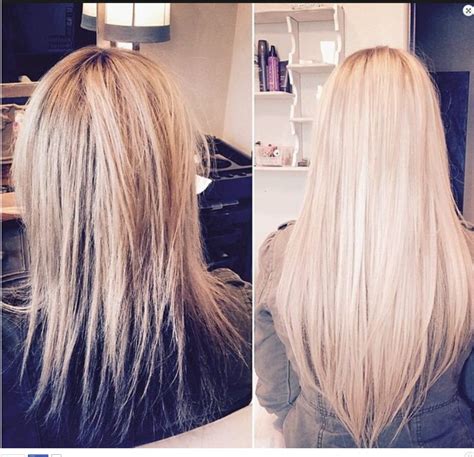Introduction
Thin hair can be a frustrating issue, affecting millions of people worldwide. According to the American Academy of Dermatology, approximately 50% of women and 25% of men experience hair loss or thinning. Fortunately, hair extensions offer an effective solution for adding volume, length, and coverage to thin hair.

8 Types of Hair Extensions for Thin Hair
1. Clip-In Extensions (4-8 tracks)
Clip-in extensions attach to your natural hair using small clips. They are versatile and easy to apply, making them ideal for occasional use.
2. Tape-In Extensions (20-40 extensions)
Tape-in extensions are thin wefts of hair attached to adhesive tape. They are applied by sandwiching your natural hair between two tapes.
3. Micro-Link Extensions (100-200 strands)
Micro-link extensions are individual strands of hair attached to your natural hair using small metal beads. They are relatively permanent and can last for 4-6 months.
4. Fusion Extensions (150-250 bonds)
Fusion extensions are keratin-tipped hair strands that are bonded to your natural hair using heat. They are the most durable and can last for 6-12 months.
5. Ponytail Extensions (1 or 2 extensions)
Ponytail extensions are simply long ponytails that attach to your natural hair. They provide instant volume and length.
6. Halo Extensions (1 piece)
Halo extensions are a circular band of hair that fits comfortably around your head. They are invisible and create a natural-looking volume.
7. Toppers (1 or more pieces)
Toppers are small hair pieces that cover the crown of your head. They are perfect for adding volume and concealing thinning areas.
8. Bangs Extensions (1 piece)
Bangs extensions are individual hair pieces that attach to your natural bangs. They provide instant coverage and can frame your face beautifully.
Choosing the Right Extensions for Thin Hair
When selecting hair extensions for thin hair, consider the following factors:
- Hair length and thickness: Choose extensions that are similar to your natural hair length and thickness to avoid creating an unnatural appearance.
- Application method: Choose an application method that suits your lifestyle and skill level.
- Color and texture: Match the extensions to your natural hair color and texture for a seamless blend.
- Budget: Hair extensions can range in price from $100 to $1,000 or more, so choose an option that fits your financial needs.
Table 1: Comparison of Hair Extension Types
| Type of Extension | Application Method | Durability | Cost |
|---|---|---|---|
| Clip-In | Clips | Temporary (can be removed daily) | Low |
| Tape-In | Tape | 4-8 weeks | Moderate |
| Micro-Link | Metal beads | 4-6 months | High |
| Fusion | Keratin bonds | 6-12 months | High |
| Ponytail | Clip or band | Temporary | Low |
| Halo | Halo band | Temporary | Moderate |
| Topper | Hooks or clips | 4-8 weeks | Moderate |
| Bangs | Clip or tape | Temporary | Low |
Strategies for Applying Hair Extensions on Thin Hair
- Use less hair: Thin hair can easily be overwhelmed by too much weight, so use fewer extensions or thinner wefts.
- Avoid over-tightening: When securing extensions, avoid pulling too tightly, as this can damage your natural hair.
- Blend carefully: Use a brush or comb to blend the extensions with your natural hair to create a seamless transition.
- Consider a volumizing spray: Apply a volumizing spray to your natural hair before attaching extensions for added lift and support.
- Don’t over-wash: Excessive washing can loosen the bond between your natural hair and the extensions. Wash your hair every 3-4 days.
Tips and Tricks for Maintaining Thin Hair with Extensions
- Use heat protectant: Always use heat protectant spray before using heat styling tools on your extensions.
- Brush gently: Brush your extensions gently to avoid snagging or tangling.
- Avoid harsh chemicals: Avoid using harsh chemicals or hair products that contain alcohol or sulfates.
- Sleep in a protective cover: Wear a satin or silk pillowcase or sleep with hair extensions in a loose braid or bun to minimize friction and damage.
- Get regular trims: Trim your extensions regularly to remove split ends and keep them looking healthy.
Common Mistakes to Avoid When Using Extensions on Thin Hair
- Using too many extensions: Overloading thin hair with extensions can cause damage and hair loss.
- Applying extensions too tightly: Pulling extensions too tightly can strain your natural hair and lead to breakage.
- Over-washing: Washing hair too frequently can loosen the bond between extensions and your natural hair.
- Using harsh products: Chemicals or hair products containing alcohol or sulfates can weaken and damage both your natural hair and extensions.
- Ignoring maintenance: Neglecting to trim or care for your extensions can lead to tangling and breakage.
Innovate with Hair Extensions: 3 Unconventional Applications
1. Creative Hair Color:
Experiment with extensions in bold or unconventional colors to create a striking and personalized look.
2. Hair Sculpting:
Use extensions to sculpt intricate designs into your hair, such as braids, buns, and updos, for a unique and eye-catching appearance.
3. Hair Jewelry:
Incorporate beads, clips, or other hair accessories into your extensions to create a customized and stylish adornment.
Conclusion
Hair extensions offer a versatile solution for adding volume, length, and coverage to thin hair. By choosing the right type of extensions and following proper application and maintenance techniques, you can create a natural-looking and confidence-boosting look. Remember to consult with a professional hairstylist for personalized guidance and to ensure the health of your natural hair.
